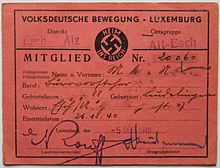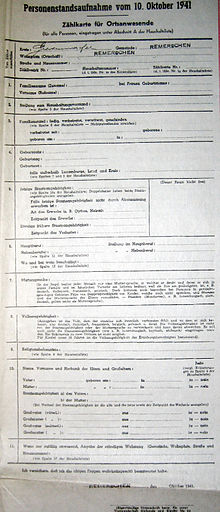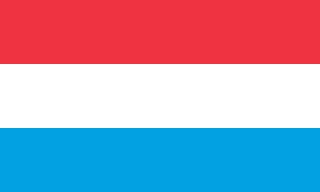
Luxembourg, officially the Grand Duchy of Luxembourg, is a small landlocked country in Western Europe. It borders Belgium to the west and north, Germany to the east, and France to the south. Its capital and most populous city, Luxembourg, is one of the four institutional seats of the European Union and the seat of several EU institutions, notably the Court of Justice of the European Union, the highest judicial authority. Luxembourg's culture, people, and languages are highly intertwined with its French and German neighbors; while Luxembourgish is the only national language of the Luxembourgish people and of the Grand Duchy of Luxembourg, French is the only language for legislation, and all three – Luxembourgish, French and German – are used for administrative matters in the country.

The history of Luxembourg consists of the history of the country of Luxembourg and its geographical area.

The Heim ins Reich was a foreign policy pursued by Adolf Hitler before and during World War II, beginning in 1938. The aim of Hitler's initiative was to convince all Volksdeutsche who were living outside Nazi Germany that they should strive to bring these regions "home" into Greater Germany, but also relocate from territories that were not under German control, following the conquest of Poland, in accordance with the Nazi–Soviet pact. The Heim ins Reich manifesto targeted areas ceded in Versailles to the newly reborn state of Poland, various lands of immigration, as well as other areas that were inhabited by significant ethnic German populations, such as the Sudetenland, Danzig, and the southeastern and northeastern regions of Europe after 6 October 1939.
The German occupation of Luxembourg in World War II began in May 1940 after the Grand Duchy of Luxembourg was invaded by Nazi Germany. Although Luxembourg was officially neutral, it was situated at a strategic point at the end of the French Maginot Line. On 10 May 1940, the German Wehrmacht invaded Luxembourg, Belgium and the Netherlands. Luxembourg was initially placed under a military administration, but later became a civilly administrated territory and finally was annexed directly into Germany. The Germans believed Luxembourg to be a Germanic state, and attempted to suppress what they perceived as alien French language and cultural influences. Although some Luxembourgers joined the resistance or collaborated with the Germans, both constituted a minority of the population. As German nationals, from 1942, many Luxembourgers were conscripted into the German military. Nearly 3,500 Luxembourgish Jews were murdered during the Holocaust. The liberation of the country by the Allies began in September 1944, but due to the Ardennes Offensive it was not completed until early 1945.
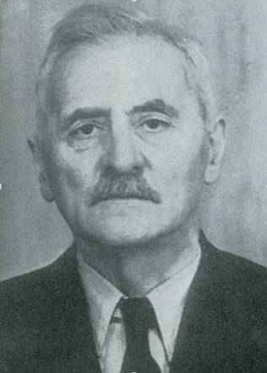
Damian Kratzenberg was a highschool teacher who became head of the Volksdeutsche Bewegung, a pro-Nazi political group, in Luxembourg during World War II. He was executed after the war for collaboration with the Nazis.

Luxembourgers are an ethnic group native to their nation state of Luxembourg, where they make up around half of the population. They share the culture of Luxembourg and speak Luxembourgish, a West Germanic language.
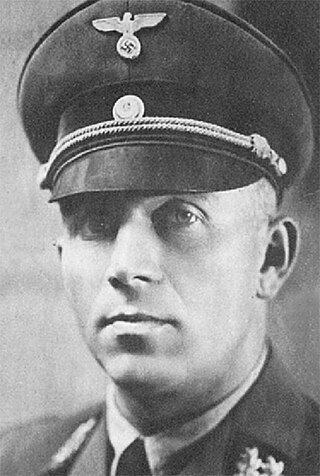
Gustav Simon was a Nazi Party official who served as Gauleiter of Gau Moselland from 1931 to 1945 and, from 1940 until 1942, as Chief of Civil Administration in occupied Luxembourg.

The history of the Jews in Luxembourg dates back to the 1200s. There are roughly 1,200 Jews in Luxembourg, and Jews form one of the largest and most important religious and ethnic minority communities in Luxembourg historically.

From August 1914 until the end of World War I on 11 November 1918, the Grand Duchy of Luxembourg was under full occupation by the German Empire. The German government justified the occupation by citing the need to support their armies in neighbouring France, although many Luxembourgers, contemporary and present, have interpreted German actions otherwise.
Émile Krieps was a Luxembourgish resistance leader, soldier, and politician. A member of the Democratic Party, Krieps served in cabinets under Pierre Werner and Gaston Thorn.
The Luxembourgish general strike of 1942 was a manifestation of passive resistance when Luxembourg was occupied by Nazi Germany during World War II. The strikes opposed a directive that conscripted young Luxembourgers into the Wehrmacht. A nationwide general strike, originating in Wiltz, paralysed the country and led to the occupying German authorities responding violently by sentencing 21 strikers to death.

The Luxembourgian Patriot League, was a Luxembourgian Resistance movement during World War II. When Luxembourg was invaded and annexed by Nazi Germany in 1940, a national consciousness started to come about. The LPL was founded on 4 September 1940 at the Lycée of Echternach in Echternach by Raymond Petit.

The Luxembourgish government in exile, also known as the Luxembourgish government in London, was the government in exile of Luxembourg during the Second World War. The government was based in London between 1940 and 1944, while Luxembourg was occupied by Nazi Germany. It was led by Pierre Dupong, and also included three other Ministers. The head of state, Grand Duchess Charlotte, also escaped from Luxembourg after the occupation. The government was bipartite, including two members from both the Party of the Right (PD) and the Socialist Workers' Party (LSAP).

The involvement of the Grand Duchy of Luxembourg in World War II began with its invasion by German forces on 10 May 1940 and lasted beyond its liberation by Allied forces in late 1944 and early 1945.
When Luxembourg was invaded and annexed by Nazi Germany in 1940, a national consciousness started to come about. From 1941 onwards, the first resistance groups, such as the Letzeburger Ro'de Lé'w or the PI-Men, were founded. Operating underground, they secretly worked against the German occupation, helping to bring political refugees and those trying to avoid being conscripted into the German forces across the border, and put out patriotic leaflets encouraging the population of Luxembourg to pull through.

During the German occupation of Luxembourg in World War II, some Luxembourgers collaborated with the country's Nazi occupiers. The term Gielemännchen was adopted by many Luxembourgers, first to describe German Nazis in general, and later for Luxembourg collaborators. The term came from the yellow uniforms of the Nazi Party. Their number, however, was limited.
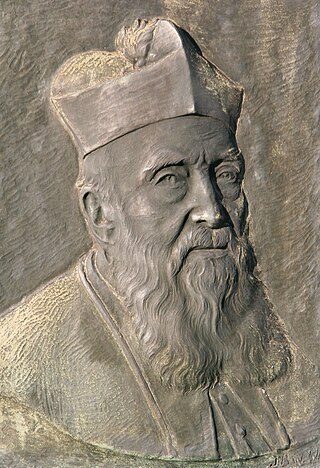
Johannes Olav Fallize, Ph.D., D.Th., was the first Roman Catholic bishop in Norway since the Reformation. As the head of the Catholic Church of Norway for 35 years, he was the Prefect Apostolic of Norway from 1887 to 1892 and the Vicar Apostolic of Norway from 1892 to 1922.

The Military Administration of Luxembourg was a German military administration in German-occupied Luxembourg that existed from 11 May 1940 to 29 July 1940, when the military administration was replaced with the Civil Administration Area of Luxembourg.
Léonie (Lily) Unden was a Luxembourg poet, painter and educator who was sent to the Ravensbrück concentration camp for taking part in the Luxembourg Resistance during the Second World War. Thanks to her flower paintings, she is remembered as one of Luxembourg's most celebrated female painters.

Germany and Luxembourg first established bilateral relations in April 1951. The two countries have shared a peaceful and friendly relationship over their 72 year relationship, especially through their mutual cooperation in international organisations such as the European Union, NATO, the OECD and the United Nations.

